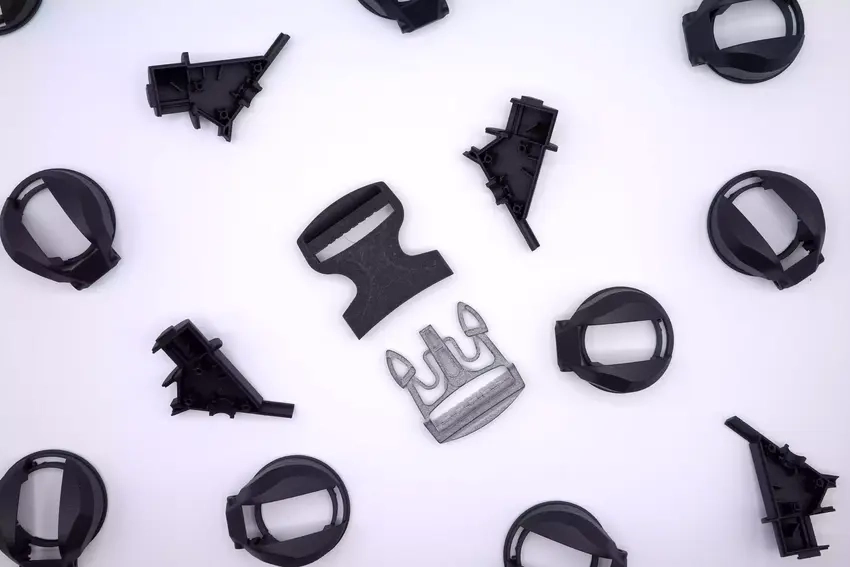 Home / Resources / Blog Articles / Mastering Custom Manufacturing: The Power of MJF 3D Printing Custom Parts
Home / Resources / Blog Articles / Mastering Custom Manufacturing: The Power of MJF 3D Printing Custom Parts April 25, 2025
April 25, 2025
MJF 3D printing custom parts have rapidly gained industry attention for their outstanding capabilities in precision manufacturing and mass customization. Developed by HP, the Multi Jet Fusion (MJF) process redefines traditional additive manufacturing through its speed, accuracy, and capacity for industrial-scale production. Unlike conventional subtractive techniques, where material is removed to form components, MJF is an additive approach that builds parts layer-by-layer, drastically reducing waste and enabling complex geometries without expensive tooling.
The significance of MJF technology lies in its ability to produce functional end-use parts with high mechanical integrity, often without the need for post-processing. This makes it a transformative solution for manufacturers seeking rapid prototyping and low-to-mid-volume production runs. In industries such as aerospace, automotive, and medical device manufacturing, where customized components are essential, MJF 3D printing custom parts offer a level of flexibility and precision that is unparalleled by traditional methods.
Moreover, digital workflows in MJF allow for streamlined design-to-production processes. CAD models can be optimized with generative design techniques and directly printed, eliminating delays caused by mold creation or setup times. This creates a competitive edge for companies that need to iterate and deliver customized products quickly, efficiently, and cost-effectively.

Understanding the core mechanics of MJF is essential for appreciating its impact on custom manufacturing. The process involves spreading a fine layer of thermoplastic powder (typically nylon) across the build bed, followed by the precise deposition of fusing and detailing agents using thermal inkjet arrays. The fusing agent defines the part’s geometry by absorbing infrared energy and bonding the powder in specific areas, while the detailing agent enhances edge definition and surface smoothness.
This method offers several technological advantages over other 3D printing methods. For instance, while Selective Laser Sintering (SLS) also uses powder-based media, it relies on high-powered lasers, which are slower and less uniform in heat distribution compared to MJF’s infrared approach. The consistent thermal energy in MJF ensures homogenous fusion, minimizing internal stress and reducing the likelihood of warping or deformation—especially critical in high-precision applications.
MJF 3D printing custom parts also benefit from high build speeds due to simultaneous printing and fusion over the entire layer, unlike point-by-point methods. The result is not only faster throughput but also higher part consistency across builds, making it ideal for scalable production and short-run manufacturing of specialized parts.
The performance of any custom part is highly dependent on the material used. MJF supports a growing portfolio of engineering-grade materials, each offering unique mechanical and thermal properties suitable for diverse use cases. Common materials include PA12, PA11, PA12GB (glass-bead reinforced), and TPU, each tailored to specific applications.
PA12 is widely recognized for its excellent balance between strength and flexibility. It resists chemical degradation, exhibits good thermal stability, and maintains dimensional accuracy under mechanical stress. This makes it a top choice for MJF 3D printing custom parts in automotive brackets, housings, and enclosures.
PA11 offers greater ductility and impact resistance compared to PA12. It is often selected for components requiring frequent motion or cyclic stress, such as living hinges or flexible joints. Derived from castor oil, PA11 is also a more sustainable alternative, aligning with environmentally conscious manufacturing strategies.
PA12GB is reinforced with glass beads to enhance rigidity and dimensional stability. It is ideal for parts subjected to static loads or higher temperature environments, such as jigs, fixtures, and structural supports.
TPU provides elastomeric properties, enabling the creation of flexible components like seals, gaskets, and wearable technology parts. Its combination of elasticity, durability, and abrasion resistance extends the application range of MJF beyond rigid structures into soft-touch, impact-absorbing components.
By selecting the appropriate material, engineers can optimize MJF 3D printing custom parts for performance, cost, and durability—critical factors in delivering products that meet stringent functional and operational requirements.
The absence of tooling constraints in MJF technology unlocks unprecedented levels of design freedom. Engineers and designers can push the boundaries of form and function, creating parts with intricate geometries, internal cavities, lattices, and integrated assemblies that would be impossible—or prohibitively expensive—to manufacture using traditional methods.
This capability is particularly important in industries where performance is directly tied to geometry, such as fluid dynamics or load distribution. For example, internal cooling channels, which are often vital in automotive or electronics applications, can be integrated directly into a part's structure. Similarly, lightweighting strategies such as gyroid lattice infills can be implemented to reduce material usage while maintaining strength.
MJF 3D printing custom parts also support mass customization without altering production costs. This is a game-changer for industries like orthopedics or consumer goods, where individualized products are in demand. With a single digital file change, a new customized part can be printed with zero tooling delays, enabling cost-efficient personalization at scale.
Furthermore, engineers can consolidate multiple parts into a single, functionally integrated component. This eliminates the need for fasteners, adhesives, and assembly labor, significantly improving reliability and reducing manufacturing complexity.
MJF 3D printing custom parts have redefined what's possible in digital manufacturing. By offering unparalleled design freedom, rapid production capabilities, and superior mechanical performance, MJF enables engineers and manufacturers to deliver innovative, highly tailored solutions with unmatched efficiency. Whether used for prototyping, short-run production, or end-use parts, MJF stands as a cornerstone of modern manufacturing strategy. As customization and speed become more vital in competitive markets, the adoption of MJF technology offers a clear path toward agile, scalable, and sustainable production. Manufacturers that embrace MJF are better positioned to meet diverse customer demands, reduce operational costs, and maintain a decisive edge in the fast-evolving industrial landscape. The era of digital, on-demand, and precision-driven manufacturing is here—and MJF is leading the charge.